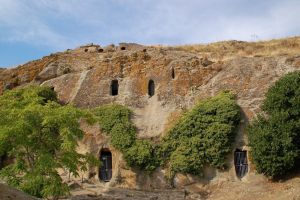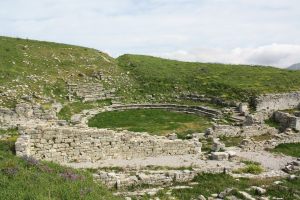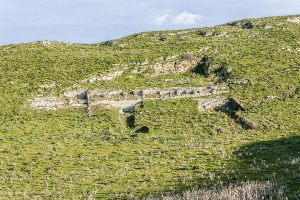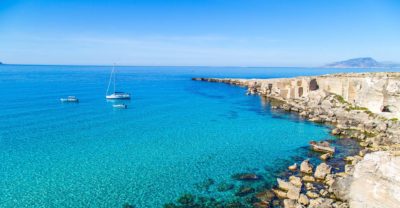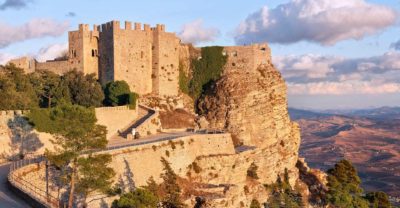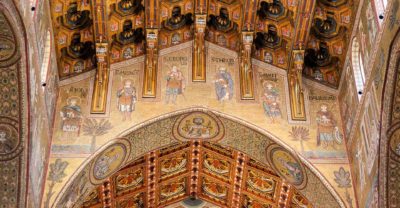Archeological sites
Palermo
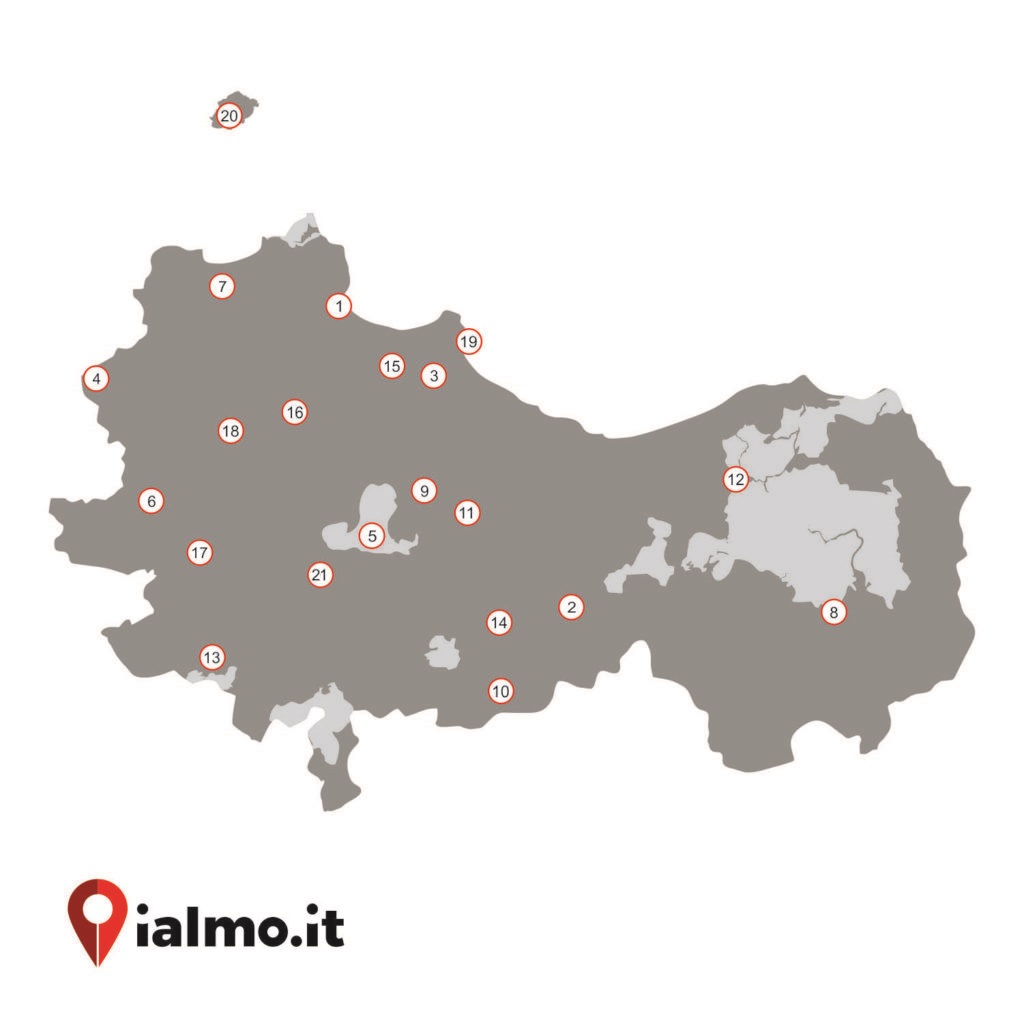
Archaeological sites of Palermo, Palermo: Of the Punic period remains the urban layout of the city, corresponding to a main urban axis, the Cassaro, and a minor road that branches off from this. Punic traces can be found in limited portions of the ancient city walls or in the Punic-Roman necropolis, located near Corso Pisani. Inside the Villa Bonanno, designed in 1905 by Giuseppe Damiani Almeyda, you can visit the remains, from the Roman era, of two domus placed in front of the Palazzo dei Normanni while other houses were found near Piazza Pretoria and Piazza Sett’Angeli . The latter site, located behind the Cathedral, is characterized by the presence of stratifications ranging from the Hellenistic-Roman to the Byzantine period. Among the remains we point out the mosaic floors of a patrician house, a coeval road section and the base part of a Byzantine pillar. From corso Alberto Amedeo, passed a nineteenth-century entrance, you enter the Catacombs of Porta d’Ossuna, datable around the IV-V century. The Catacombs wind in the subsoil for several meters in a north-south direction. Two other catacombal areas of the same period are those of San Michele Arcangelo and Santissimi Quaranta Martiri. The Archaeological Park of Castellammare is located near the Cala and includes the remains of the castle-fortress of the Norman period, an Islamic necropolis and the remains of the Church of Santa Maria di Piedigrotta, almost entirely razed to the ground by the bombings of 1943. Catacombs of the Capuchins: obligatory stage of the Grand Tour, they are famous all over the world and are located in the basement of the Convento dei Cappuccini, in the Cuban quarter, annexed to the Church of Santa Maria della Pace. The tunnels, dug at the end of the 16th century, form a large rectangular cemetery housing about 8,000 mummified corpses. Catacombs of San Michele Arcangelo: underground complex originally used as a burial site with chapels, niches and tombs still visible.
Caves of the Gurfa, Alia: they are located a few kilometers from the village and represent an unusual example of rock architecture. The six caves are dug along a wall of red sandstone and arranged on two floors. Their origin seems to date back to the IV / VI millennium BC. On the lower level two large rooms have been created with independent entrances communicating through a gallery. The first compartment has a quadrangular plan and has a sloping roof with a central ridge. The second environment, with a circular plan, has a bell-shaped profile that culminates in a central hole. Through steps carved into the rock wall one reaches the upper level consisting of four rectangular-shaped rooms communicating with each other through short passages. The second level faces into the large space of the bell-shaped compartment. The monumental thòlos environment of the Gurfa, with its burial chamber from the “awning” roof of the ground floor, can be associated with the Hellenic ones, dated around 1400 B.C.
Monte Porcara, Bagheria: archaeological site dated between the seventh and third centuries BC and identifiable with the indigenous city of Paropo. Near the top of the mountain there are few remains of the city walls and the necropolis made up of coffer burials in calcarenite slabs and monolithic sarcophagi of the same material.
Castle of Calatubo, Balestrate: the ruins of the Castle, dating back to the Byzantine era, dominate the town from a hill. From the inside of the city walls, 250 meters long and following an irregular triangular pattern, you can enjoy a beautiful landscape. On the sides there are two square towers. Among the other sites that can be visited in the outskirts of the town, there is an ancient Greek necropolis, dating back to the VI / V century BC, and some traces of Arab tombs.
Rocca Busambra, Campofelice di Fitalia: in this area have been found important evidence of settlements dating back to the eighth century BC. and belonging to the culture of Sant’Angelo Muxaro. In the same area graves of Hellenistic and medieval times have been brought to light.
Sites of Camporeale, Camporeale:
Monte Pietroso is a rise that stands behind the modern town of Camporeale and slopes gently down to the north towards the valley that leads to the Jato. On the top of Mount Pietroso the soil is littered with fragments of indigenous ceramics painted in bands or incised similar to those found at Segesta. Traces of masonry that can be linked to the existence of a living inhabited center from the 6th to the 4th century have also been identified. B.C. and two necropolis. One of the two necropolises was almost entirely destroyed by the agricultural works, while in the second, consisting of very large terrestrial pits and protected by low walls, the abundance of bone remains would indicate its use for multiple depositions and incinerations. The numerous ceramic fragments are of Attic and Ionic type. Bronze and iron fragments have also been found.
In the Valdibella area, commonly referred to as Guardibella, the Palermitan archaeological group has verified the existence of an area rich in terracotta fragments. The fragments found refer to the Roman period. Of particular interest is the discovery of part of a mosaic with white tesserae and some fragments of columns.
Archaeological sites of Carini, Carini:
Baglio-Carburangeli archaeological area: inside the pit graves, finds have been found that reveal the occupation of the territory since the III century BC. Among the most important findings we mention amphorae, lava stone mills, fragments of oil lamps and a marble column base from the late Roman era;
Archaeological area of the San Nicola district: important finds from the Roman-Byzantine era have been found, including a basilica mosaic and a Byzantine coin from the age of Justinian. In the east coast of Carburangeli, an area rich in V century ceramics was also discovered. B.C.;
Moscala archaeological area: on the site the remains of an urban settlement have been found (with traces of walls, boulders of worked tuff, tools and fragments of ceramics) referable to the III, IV and V sec. B.C.;
Archeological area Manico di Quarara: necropolis referable to the Elymian civilization;
Ciachea archaeological area: near the border between Capaci and Carini there is a vast necropolis, dating back to the Eneolithic, where the Bicchiere di Carini pottery has been found, unique in its workmanship and dated back to 4,000 BC .;
The catacombs found near Villagrazia di Carini confirm the existence of a vast Christian community in the territory and a bishop’s seat. Of notable interest are the numerous caves distributed throughout the territory, rich in numerous remains of prehistoric fauna.
Grotte di Castellana Sicula, Castellana Sicula: the surroundings of the municipality are an area particularly rich in caves and archaeological sites of great interest. Among these are: the Cave of Calcarelli, Cozzo Morto, Cozzo Zara, Zarotta, Cozzo Re, San Giacinto, the Caves of Valle Maimone and the Grotta del Vecchiuzzo. Then we report in the village of Calcarelli evidence of a Roman settlement of the first and second century AD.
Sites of Cefalà Diana-Villafrati, Cefalà Diana-Villafrati: near the Colle di Costa d’Ape and on the southeast side of Pizzo Chiarastella there are some caves of great archaeological interest. The most important is undoubtedly the Grotta Buffa which preserves burials of human remains dating back to the Eneolithic age (3.500-2.000 BC). On the south-western side, instead, there are remains of stone buildings and some fragments of tiles and ceramics that suggest the existence of an ancient village made up of huts with flints. Still noteworthy within the territory belong to the nature reserve oriented Bagni di Cefalà Diana and Chiarastella the so-called “Arab Baths”.
Contrada Grotte, Castronovo di Sicilia: remains of primitive dwellings belonging to the Sicans have been found on the site on the banks of the river Platani. The first studies on these settlements were conducted in 1743 by the local historian Vito Mastrangelo who identified some hieroglyphs on the walls of some caves. In the larger one, where the maidenhair plant also flourishes, forms of seats carved into the rock can be observed.
Archaeological site of Pizzo di Ciminna, Ciminna: recent excavation campaigns conducted in the municipal area have highlighted the presence of a very large and important archaeological heritage.
Archaeological site of Monte d’Oro, Collesano: it houses the ruins of an ancient village of Islamic age but already existing probably in the Byzantine age. Visible numerous ruins of houses, fortification walls, lookout towers and a probable fortress. Among the finds there are ceramic finds dating back to the Greco-Roman era, a money dating back to the Swabian age, a bronze fibula, a lamp and a considerable quantity of raw ceramics, canteen and preserves.
Archaeological site of Entella, Contessa Entellina: frequented of the Eneolithic and from the Bronze Age, the plateau and the slopes of Rocca d’Entella show eloquent remains of the ancient city of Entella. The city, flourishing from the Archaic period to the first imperial age and then again in the Middle Ages, was definitively abandoned in 1246. From the Hellenistic period are most of the tombs of the necropolis as evidenced by the type of burial and the pottery found in them.
Site of Colle Madore, Lercara Friddi: on the Hill, located about 2 km from the village, numerous excavation campaigns have been conducted by the Superintendence of Cultural and Environmental Heritage of Palermo which have brought to light an ancient sacred area under the top) flanked by rooms dedicated to metallurgical production. The finds found in the excavations are now exhibited at the local civic museum.
Pizzo Cannita, Misilmeri: archaeological site dating back to the VIII century BC where the ruins of a temple dedicated to Chronos were found. Today many of the finds found on the site are kept at the Regional Archaeological Museum of Palermo.
Pirama, Piana degli Albanesi: in the Sant’Agata district there is the ancient settlement called Pirama. The site also includes an important early Christian necropolis of late Roman age. The important discovery gave further confirmation of the ancient and modern cultural productivity of the territory.
Archaeological area of Monte Maranfusa, Roccamena: recent excavations in the area have revealed the existence of an ancient settlement of the Elimi (V / IV century BC) to which were added the findings of other buildings dating back to centuries earlier.
Archaeological Park of Mount Jato, San Cipirello-San Giuseppe Jato: the excavations conducted in 1971 by a team of the University of Zurich on top of Mount Jato have brought to the surface the ancient city, inhabited since the IX century BC. to 1246. This is the acropolis with the agora (paved with sandstone slabs), the theater (with 4,400 seats), the temple of Aphrodite and the house peristyle. The latter, dating back to the 2nd century BC, is one of the largest private homes in the Hellenistic world that has come down to us.
Solunto archaeological area, Santa Flavia: located on the summit of Monte Catalfano, in the extreme point of Capo Zafferano. The remains of the city of Phoenician origin, founded in the 4th century BC, keep the plant still intact of houses and temples, among which stand out the mosaics of the houses and the ruins of the Greek-Roman theater, surrounded by high steps. A dwelling inside houses a fresco depicting the myth of Leda, the mythological heroine to whom the house is called. The precious finds found in the area are now kept in the Antiquarium of Solunto.
Village of the Faraglioni, Ustica: of prehistoric age, it is only one of the many archaeological sites of which the island is rich. A Roman necropolis in the Falconiera area is still to be reported in Ustica.
Montagna Vecchia, Corleone: the area halfway up the west side of the Mountain, is crossed by a sacred path dedicated, almost certainly, to the cult of Demeter that in the archaeological sites of this area represented the cult most practiced by far. This element is confirmed by surface research, from archaeological excavations carried out in Pizzo Spolentino in 1993 and from the discovery of the sacred area located in the district of the SS. Salvatore between the homonymous street and the cliff of the Rocca dei Maschi. The sacred path of Demeter, discovered thanks to the work of the archaeologists Angelo Vintaloro and Mario Orlando, has had great resonance in the Corleone community.
